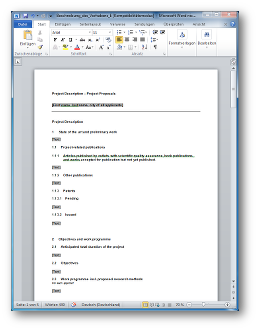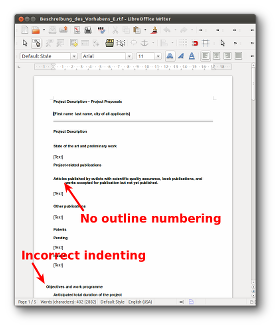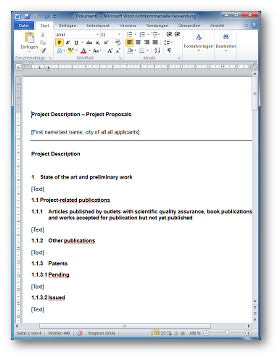Project template for DFG proposals
The German Research Foundation (Deutsche Forschungsgemeinschaft,
DFG) offers templates for research project descriptions for download
in rich-text format (.RTF). I suspect that this file type was
chosen for its assumed interchangeability as opposed to the proprietary
Microsoft® Word .DOC format.
It turns out however that .RTF files are neither standardized nor
particularly interchangeable.
The .RTF file type was invented and is continuously developed by
Microsoft. It is a proprietary format, and it was never publicly
standardized. On the other hand, both Microsoft’s own Office Open XML
(.DOCX) as well as The Document Foundation’s OpenDocument format
(.ODT) have been published as ISO standards. In addition, the default
file type used by Word 2003 and later (.DOC) has been widely used for
over a decade. I am probably not alone in thinking that .DOC files have
become a de-facto industry standard.
Importing a rich-text file leads to different results depending on the software package used
The following screenshots demonstrate the differences between Microsoft
Word 2010 (left) and LibreOffice Writer 4.1.3.2 (right) when the DFG
project template (.RTF) is imported:
The outline numbering is lost when the file is imported into LibreOffice, and the indenting is off.
It occurs to me that by choosing .RTF as their preferred file type, the
DFG inadvertently prevents interchangeability and ties users to Microsoft
Word, when what they obviously (to me, at least) wanted to achieve is the
exact opposite, i.e. to offer an interchangeable, open, non-Microsoft
file template.
OpenDocument text template for project proposals
I am an ardent user of the OpenOffice/LibreOffice Writer
application which I think is a better alternative to the recent editions
of Microsoft’s Word, especially for writing scientific documents
(Microsoft Excel however is unsurpassed, but that is a different story).
Therefore I was a bit disappointed when I discovered that the .RTF
project template file offered by the DFG is not imported properly into
Writer, and I decided to quickly create an .OTT template file myself.
The template file that I created closely mimicks the original DFG template, including several typographic errors. It makes full and proper use of paragraph styles, which are organized in a hierarchical manner. Thus, should the need arise, one can quickly re-format the entire document.
I release this .OTT OpenDocument template file into the public domain to
help anyone who is in a similar situation as I was.
Use it at your own risk!
Note: The template was updated based on the current version “06/15” on the DFG server.
Proof of Concept
As opposed to .RTF files, OpenDocument files are ISO-standardized, and
they can be used with LibreOffice/OpenOffice as well as Microsoft Office.
(Frankly, I don’t know how Apple’s Pages application handles either of
these file types.)
So how does Microsoft Word import the .OTT template file? Well, first of
all, since it is an .OTT template rather than an .ODT text document,
Windows won’t recognize it for what it is. You have to either change the
file extension to .ODT, or tell Windows explicitly to open the file with
Word.
When importing the file, Word will complain that the .ODT/.OTT file is
‘damaged’ and contains ‘unreadable content’. How surprising that Word
should not open a non-Microsoft file without much a-do! However, one can
safely dismiss the error message, and then confirm to open the file by
clicking ‘Yes’.
The result looks as expected (click to zoom):
Thus, interchangeability of a document that contains outline numbering is achieved using an ISO-standardized, open file format, q.e.d.
Of course, if more advanced features such as embedding graphs and pictures are needed, I would not be surprised if none of these programs are able to deal with ‘foreign’ files.
Post date
Thu 8 Jan 2015Tags
Share
Recent posts
Exit ThinkPad T430s, enter ThinkPad T480s
Linux and VirtualBox on a T480s with high-resolution display
What I like and dislike about Ubuntu 18.04


